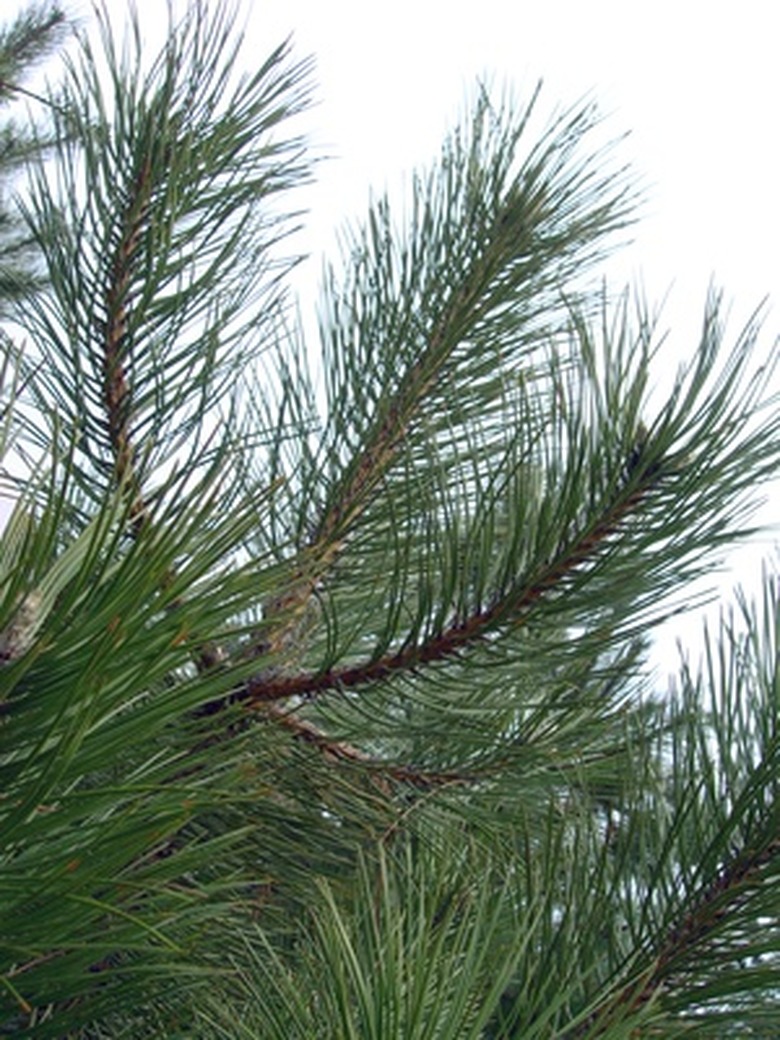Facts About Pine Needles
Pine trees go about their essential work converting energy from the sun into the fuel they need to grow and survive – photosynthesis, in other words – via green leaves of a distinctive form shared by many other conifers: needles. As with any other tree variety's primary leaves, pine needles must take in and release the gases involved in photosynthesis and respiration and also regulate water loss (transpiration) – an especially significant issue in the dry climates where many temperate and subtropical pine species prosper.
The Form of Pine Leaves
The Form of Pine Leaves
The basic design of pine needles helps explain the trees' competitive edge in dry climates. Their exceedingly narrow form reduces the surface area exposed to dehydration, and the waxy coating, or cuticle, outside the thick epidermis provides a barrier to water loss. The stomata – openings in leaves for gas exchange through which water also escapes, or transpires – are set within pits to provide a "boundary layer" of still air; moving air increases the rate of transpiration. The pit-set stomata of pine needles come aligned in rows, and where they're found on the leaf surface can help you differentiate between the two major subgroupings of the Pinus genus: In the "soft" or "white" pines (subgenus Strobus), the stomata line one side of the needle, while in the "hard" pines (subgenus Pinus), stomata are found on both upper and lower surfaces of the needle.
Needle length varies widely among pines. The longleaf pine of the American Southeast earns its name honestly: Its needles may be as long as 18 inches, the length champions of the genus. Compare that with the stubby needles of many piñon pines as well as the subalpine bristlecone and foxtail pines of the western U.S., which may be a mere inch long.
A sheath of bud scales covers the base of the needle bundle; in the soft pines that sheath falls away when the needles mature, while in the hard pines it persists.
Arrangement of Pine Needles
Arrangement
of Pine Needles
Pine needles grow off dwarf shoots in bunches called fascicles. Most of these bundles consist of two, three or five needles, but there's plenty of variation even within a given species; ponderosa pine, for example – the second-largest pine in the world and among the signature trees of the American West – typically sports three needles per fascicle, but many ponderosas east of the Continental Divide have two. At the extremes, the single-leaf piñon of the Great Basin (as you might guess from the name) grows one needle to a bundle, while the Durango pine of Mexico's Sierra Madre Occidental can have as many as eight. Needles of most pines have edges, the number of which can be used to help identify the species; the singleleaf piñon, bucking the trend, has round needles.
Pine Foliage: Evergreen
Pine
Foliage: Evergreen
Like most conifers, pines are evergreen: In other words, they retain their leaves throughout the year. This doesn't mean, of course, that the trees don't shed and replace needles; they just do so on a staggered basis. The persistence of needles varies widely between species: They may last for as little as a year or two or as many as several decades. Generally speaking tropical pines hold their needles only a few years at most, temperate pines for several years and high-elevation species the longest; needles of the Great Basin bristlecone pine, which happens to be the longest-living tree known, may persist for as long as a half-century, more than any other conifer.
Pine Needles and Fire
Pine
Needles and Fire
As discussed above, the form of a pine needle hints at the success pines have in semiarid ecosystems where minimizing water loss is critical for plants. Pines also tend to prosper in environments that historically burned in wildfire regularly (including many of those semiarid settings). Thanks to thick bark and other adaptations, many pine species can survive low-intensity fires, which in turn kill other conifers and/or hardwood trees that might eventually edge the pines out; in other words, many pine forests and savannas – including ponderosa stands in the West, longleaf pinelands in the Southeast and jack-pine woods in boreal North America – are fire-maintained. (Certain species, including jack pines and lodgepole pines, bear a percentage of cones that can only open – and thus spread seed – when exposed to the heat of a wildfire.)
Pine needles play a role in this system. Shed needles can make a thick layer of duff on the pinewood floor, and these ignite readily (by, for example, lightning). The surface fires that consume such litter don't typically kill mature pines while "flushing" out the seedlings of competing trees, so in a sense pines help perpetuate themselves by their own dropped foliage.
References
- Trees: Their Natural History; Peter A. Thomas
- The Gymnosperm Database: Pinus (Pine)
- Conifers of the World; James E. Eckenwalder
- Ecology & Biogeography of Pinus; David M. Richardson (ed.)
- Northwest Trees; Stephen F. Arno, Ramona P. Hammerly
- The Growing Tree; Brayton F. Wilson
- Fire Ecology of Pacific Northwest Forests; James K. Agee
- The Gymnosperm Database: Pinus Ponderosa
Cite This Article
MLA
Shaw, Ethan. "Facts About Pine Needles" sciencing.com, https://www.sciencing.com/pine-needles-6455979/. 22 November 2019.
APA
Shaw, Ethan. (2019, November 22). Facts About Pine Needles. sciencing.com. Retrieved from https://www.sciencing.com/pine-needles-6455979/
Chicago
Shaw, Ethan. Facts About Pine Needles last modified March 24, 2022. https://www.sciencing.com/pine-needles-6455979/
